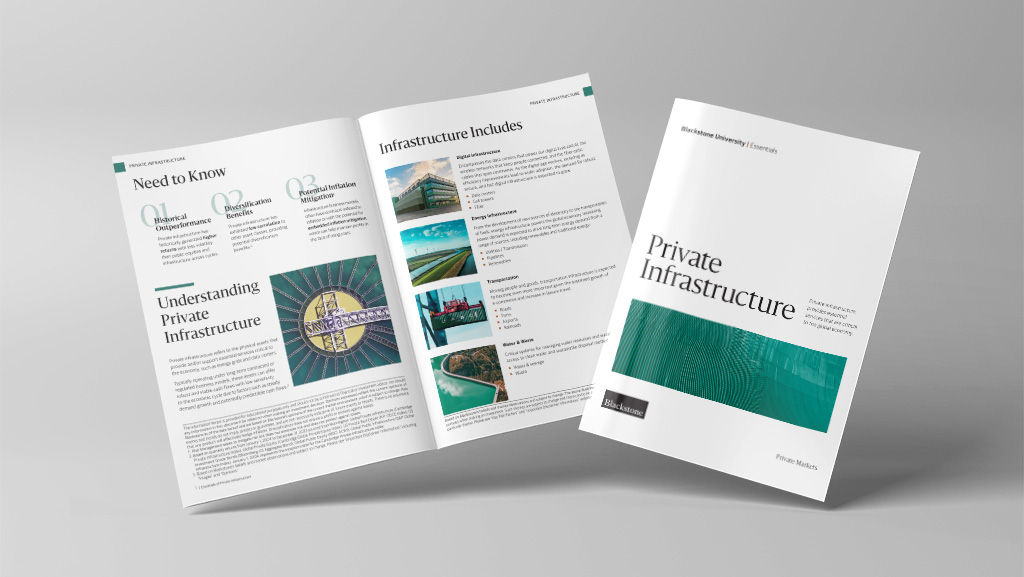Essentials of Private Infrastructure
Private infrastructure provides essential services that are critical to the global economy.
Download brochure
introduction to Private INFRASTRUCTURE

Historical Outperformance
Private infrastructure has historically generated higher returns with less volatility than public equities and infrastructure across cycles.[ 1 ]

Diversification Benefits
Private infrastructure has exhibited low correlation to other asset classes, providing potential diversification benefits.[ 2 ]

Potential Inflation Mitigation[ 3 ]
Infrastructure business models often have contracts indexed to inflation or with the potential for embedded inflation mitigation, which can help maintain profits in the face of rising costs.
Understanding Private Infrastructure
Private infrastructure refers to the physical assets that provide and/or support essential services critical to the economy, such as energy grids and data centers.
Typically operating under long-term contracted or regulated business models, these assets can offer robust and stable cash flows with low sensitivity to the economic cycle, due to factors such as steady demand growth and potentially predictable cash flows.[ 4 ]

Infrastructure Includes[ 5 ]
Digital Infrastructure
Digital Infrastructure
Encompasses the data centers that power our digital lives and AI, the wireless networks that keep people connected, and the fiber-optic cables that span continents. As the digital age evolves, including as efficiency improvements lead to wider adoption, the demand for robust, secure, and fast digital infrastructure is expected to grow.

Energy Infrastructure
Energy Infrastructure
From the development of new sources of electricity to the transportation of fuels, energy infrastructure powers the global economy. Increasing power demand is expected to drive long-term energy demand from a range of sources, including renewables and traditional energy.
- Utilities / Transmission
- Pipelines
- Renewables

Transportation
Transportation
Moving people and goods; transportation infrastructure is expected to become even more important given the sustained growth of e-commerce and increase in leisure travel.

Water & Waste
Water & Waste
Critical systems for managing water resources and waste, ensuring access to clean water and sustainable disposal methods.

Why Private Infrastructure?
We believe infrastructure assets can be an important allocation in investor portfolios, potentially delivering robust returns, diversification benefits, inflation mitigation, and yield.[ 6 ]
Private infrastructure has historically delivered higher returns with lower volatility than public markets across cycles (Exhibit 1).[ 7 ]
Private infrastructure has historically exhibited low correlation to traditional asset classes, including public equities, private real estate and private equity, providing potential diversification benefits to investors.[ 8 ]
Private infrastructure can also deliver inflation mitigation as infrastructure business models often have contracts indexed to inflation or with embedded inflation mitigants, which can help maintain profits in the face of rising costs. Lastly, private Infrastructure can be a steady source of income for investors due to the long-term contracts in place.[ 9 ]
Exhibit 1: Growth of $100,000 Investment[ 10 ]
Accessing Megatrends
Infrastructure as an asset class is broader than bridges and tunnels – for instance it can include cutting-edge sectors of the economy, such as data centers. When investing in private infrastructure, selecting the right sectors, markets and assets can be critical to generating strong performance. It is important to focus on high-quality assets with attractive growth potential driven by long-term, secular tailwinds.
This means identifying and concentrating capital around major trends, such as the rise of leisure travel, or the growth in cloud computing and artificial intelligence.
Manager selection is also critical to success. Blackstone is the world’s largest alternative asset manager[ 11 ] with a nearly 40-year track record.
CASE STUDY
Case Study: AirTrunk[ 12 ]
In 2024, Blackstone acquired AirTrunk, the largest data center platform in the Asia-Pacific region and Blackstone’s largest APAC investment to date.[ 13 ] This transaction exemplifies Blackstone’s ability to invest at scale behind high-conviction themes, capitalizing on long term trends in data growth. We believe Cloud computing, content creation and now artificial intelligence are driving robust demand for digital infrastructure. In fact, more data was created in the last three years (2021-2024) than all prior history combined (Exhibit 2).
Blackstone views the rise of artificial intelligence as an engine for future growth in digital infrastructure assets.

Singapore

Australia

EXHIBIT 2: Explosive Growth in Data[ 14 ]
(Data created, consumed & stored in zettabytes)
Allocations Growing
Private infrastructure has attracted over $1 trillion from investors and has grown roughly 7x as an asset class since 2010. [ 15 ] Institutional investors are increasing allocations: the average infrastructure allocation has double over the past five years (Exhibit 3).
Individual investors are markedly under-allocated to private infrastructure, especially when compared to institutional investors. Eligible individual investors can now invest in private infrastructure through perpetual funds. These funds have potentially appealing attributes[ 17 ] including:
- Immediate investment of capital from the moment of subscription, eliminating any waiting for money to be put to work
- The flexibility for investors to subscribe to or redeem out of the fund periodically, based on the fund’s net asset value (NAV), within certain restrictions
EXHIBIT 3: Private Infrastructure Allocations[ 16 ]
Institutions have nearly doubled their allocations since 2018
Considerations Before Allocating
Ultimately, private market investing means active ownership of less liquid assets. Liquidity needs at the total portfolio level are one important consideration before allocating to private infrastructure. In addition, manager selection may be of particular importance given that we have seen certain infrastructure managers include “infrastructure-like” investments in their portfolios. Key manager attributes include scale, staying power and a potentially differentiated ability to source strategically located, hard-asset infrastructure.
Read the complete Essentials of Private Infrastructure
Read the complete Essentials of Private Infrastructure

